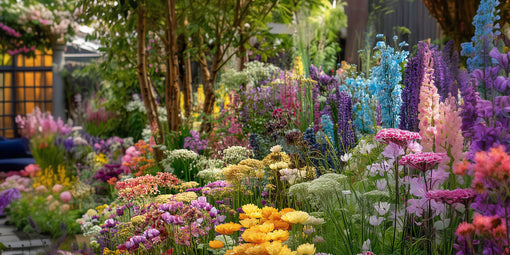
- Article published at:
Drawer menu
Welcome to the colourful world of gerberas, one of the most cheerful and vibrant flowers you can find. These blooms are a favorite in floral arrangements and gardens alike, thanks to their stunning colours and long-lasting beauty.

Gerberas were first discovered in South Africa in the late 19th century by botanist Robert Jameson, after whom the Gerbera jamesonii is named. These flowers quickly gained popularity due to their bright colours and large, daisy-like appearance.
Over time, they spread to various parts of the world, including Europe and the United States, where they became a beloved garden and florist staple. Today, gerberas are grown in many countries and are particularly popular in the Netherlands, a major hub for flower cultivation.
Gerberas are known for their striking appearance, with large, daisy-like flowers that can reach up to 5 inches in diameter. They come in a wide array of colours, including vibrant reds, oranges, pinks, yellows, and even purples. The center of the flower can be black or green, adding to its unique look.
Gerberas have a sturdy, leafless stem that supports the flower head, making them perfect for cutting and arranging. The plant itself typically has a rosette of large, lobed leaves that grow close to the ground.

Gerberas come in several types, each with its own unique charm:
These are the most common type, featuring a single row of petals around the center disk. They are simple yet striking and come in a variety of colours.
These have multiple rows of petals, giving them a fuller appearance. They are often used in more elaborate floral arrangements due to their lush look.
These gerberas have double rows of petals with an additional row of smaller, petal-like structures in the center, adding texture and depth.
These flowers are similar to crested doubles but have even more petal layers, creating a very full and intricate bloom.
Growing gerberas can be a rewarding experience if you provide them with the right conditions:
Gerberas thrive in warm climates and well-draining soil. They prefer temperatures between 15-24°C and do not tolerate frost well. The soil should be rich in organic matter with a pH between 5.5 and 6.5.
You can grow gerberas from seeds, seedlings, or cuttings. If planting seeds, start them indoors in a seed tray and transplant them once they have a few true leaves. Seedlings and cuttings can be planted directly in the garden or in pots.
Gerberas need regular watering but do not like to sit in water. Ensure the soil is moist but not soggy. Fertilize them every two weeks with a balanced fertiliser during the growing season. They require full sun to partial shade, with at least 6 hours of direct sunlight daily.
Gerberas can be susceptible to pests like aphids, spider mites, and whiteflies. Use insecticidal soap or neem oil to manage these pests. They can also be affected by fungal diseases such as powdery mildew and root rot. Ensure good air circulation and avoid overwatering to prevent these issues.

Maintaining healthy gerberas involves a few simple steps. Regularly remove dead or damaged leaves and spent flowers to encourage new growth. This process, known as deadheading, helps prolong the blooming period. In cooler climates, consider bringing potted gerberas indoors during the winter or providing them with frost protection.
In hotter climates, provide some afternoon shade to prevent heat stress. To keep your gerberas blooming longer, ensure they receive adequate water and nutrients. Deadheading also promotes continuous flowering. In regions with frost, overwinter gerberas by digging up the plants and storing them in a cool, dry place. Alternatively, grow them in pots that can be brought indoors during the winter months.

Gerberas are incredibly versatile and can be used in various ways:
Gerberas are a popular choice for bouquets, centerpieces, and other floral arrangements due to their vibrant colours and sturdy stems. They add a cheerful touch to any setting.
In the garden, gerberas can be used as border plants, in mixed beds, or in pots. Their bright flowers attract pollinators like bees and butterflies, enhancing the garden's biodiversity.
Gerberas symbolise innocence, purity, and cheerfulness. They are often given as gifts for birthdays, anniversaries, and other celebrations to convey joy and positivity.
Get creative with gerberas by using them in DIY projects like flower crowns, pressed flower art, or homemade greeting cards. Their bold colors and shapes make them ideal for crafting.
Here are some interesting tidbits about gerberas:

Gerberas pair well with various flowers and plants. Combine gerberas with roses, lilies, or daisies for a stunning bouquet. They also look great with greenery like ferns and eucalyptus.
In the garden, plant gerberas alongside other sun-loving flowers like marigolds, zinnias, and petunias. Their bright colors complement each other beautifully.
For a summer theme, pair yellow and orange gerberas with sunflowers and snapdragons. In spring, mix pastel gerberas with tulips and daffodils for a fresh look.
Gerberas are truly a delight for any flower lover. Their vibrant colours, diverse varieties, and ease of care make them a fantastic choice for gardens and floral arrangements. Whether you're brightening your home, gifting a cheerful bouquet, or enhancing your garden's beauty, gerberas are sure to impress. With their longevity in gardens and vases, they offer lasting beauty and are versatile in various settings.
Whether you're a novice or seasoned gardener, gerberas are accessible and bring nature's charm indoors as potted plants. Symbolising innocence, purity, and cheerfulness, they make perfect gifts to convey happiness and positivity. Embrace gerberas to enrich your surroundings with their vibrant colours and stunning blooms, bringing joy and a splash of nature's beauty into your life.